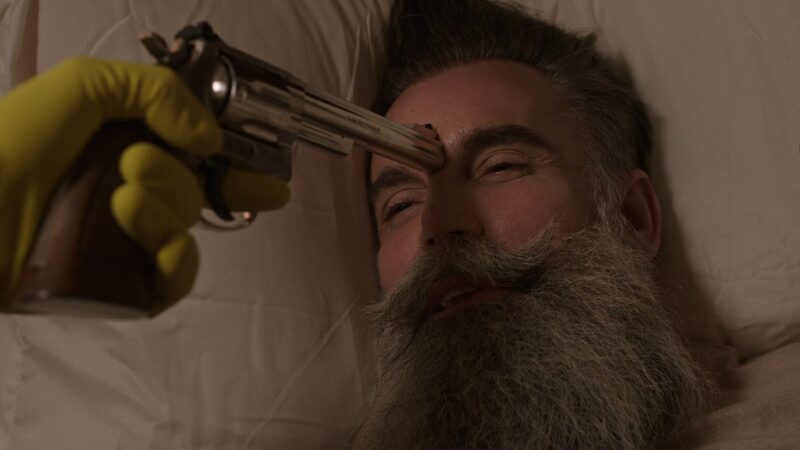
Monsters Reborn in the Age of Soap and Shadows
MOVIE REVIEW
Dan Curtis' Classic Monsters (Kino Cult #39) (Blu-ray)
Dracula
Frankenstein
The Strange Case of Dr. Jekyll and Mr. Hyde
Genre: Horror, Television, Anthology
Year Released: 1974 / 1973 / 1968, Kino Cult Blu-ray 2025
Runtime: 1h 38m / 1h 40m / 2h 23m
Director(s): Dan Curtis / Glenn Jordan / Charles Jarrott
Writer(s): Richard Matheson / Richard Matheson / Dan Curtis
Cast: Jack Palance, Simon Ward, Fiona Lewis / Bo Svenson, Robert Foxworth, Susan Strasberg / Jack Palance, Denholm Elliott, Leo Genn
Where to Watch: available October 28, 2025, pre-order your copy here: www.kinolorber.com or www.amazon.com
RAVING REVIEW: DAN CURTIS’ CLASSIC MONSTERS arrives like a midnight séance—summoning the very foundation of horror storytelling into the comforting glow of the TV. The set puts three of the most ambitious TV horror productions of their time: DRACULA (1974), FRANKENSTEIN (1973), and THE STRANGE CASE OF DR. JEKYLL & MR. HYDE (1968). Produced or directed by Dan Curtis, the man responsible for DARK SHADOWS (so maybe I have a soft spot), these films represent a remarkable collision between the gothic grandeur of Universal’s golden age and the intimacy of 70s television. What Kino Lorber presents here under its Kino Cult banner is not merely a nostalgia trip—it’s a reclamation of television horror as art, which thrives within constraints rather than collapsing under them.
In an age before streaming, before even cable had become commonplace, Curtis was already constructing worlds where horror breathed through everyday emotion. His DRACULA, adapted by Richard Matheson and filmed in Eastern Europe, was among the first to link Stoker’s Count with the historical Vlad the Impaler. This concept now feels standard, but was groundbreaking in 1974. Jack Palance, with his square jaw and feral stare, turns what could’ve been a stiff TV monster into a tragic, impulsive force—his vampirism driven as much by grief as by hunger. The performance bridges the classic and the modern day, infusing the myth with vulnerability without losing its menace.
FRANKENSTEIN, directed by Glenn Jordan, takes a different approach entirely. Bo Svenson’s creature isn’t a brute stitched from clichés but a fragile being haunted by its own reflection. Opposite him, Robert Foxworth’s Victor Frankenstein embodies an obsession with the arrogance of a man convinced that genius excuses cruelty. The film’s made-for-TV origins mean the horror must come from suggestion rather than spectacle, and that limitation becomes its strength. The emotional tension, framed through flickering candlelight and restrained production design, gives it a haunting melancholy that few theatrical versions capture. When Svenson’s monster reaches out—literally and figuratively—it’s less about shock and more about sorrow. Curtis knew that television, at its best, was built for empathy.
Then there’s DR. JEKYLL & MR. HYDE, perhaps the most traditionally gothic of the trio, but also the most psychologically raw. Palance returns, this time playing both sides of humanity’s fractured past. His Hyde is grotesque, not through prosthetics but through posture and expression—an eruption of repressed violence that television censors must have barely tolerated. The film’s moral feels ripped from a Greek tragedy rather than a Victorian parable, and yet Curtis directs it with immediacy. There’s nothing quaint or safe about this transformation; it’s as if the medium itself can barely contain what Hyde represents.
Across all three works, one constant emerges: Dan Curtis understood horror not as a parade of monsters but as a mirror for fear, guilt, and yearning. His sensibilities—soaked in gothic excess and emotional sincerity—were often dismissed as “camp” by early critics. Yet, in retrospect, they’re part of a long lineage of genre storytelling that blurs sentiment and terror. Much like his soap opera DARK SHADOWS, these films transform melodrama into mythology. They remind us that the heart of horror has always been human, whether it’s a scientist chasing immortality, a nobleman cursed by immortality, or a man at war with his own darker nature.
Kino Lorber’s presentation honors that legacy with the kind of care Curtis’ work rarely received in his lifetime. The set includes commentaries by genre historians, cast interviews, and a wealth of archival materials that contextualize each production within both its network limitations and its creative breakthroughs. The inclusion of Matheson’s perspective, in particular, sheds light on how DRACULA was conceived as a character-driven tragedy rather than a supernatural adventure. Together, these extras turn what could have been a mere compilation into a living document of a filmmaker’s vision.
Colors lean toward the warmer side of the palette Curtis favored—deep reds, golden browns, and candlelit shadows. The transfer retains the grain of the original broadcast film stock, giving each frame a texture that feels appropriately aged without ever looking murky. You still feel the hiss of the analog source, a welcome reminder of the era’s charm. The result is a viewing experience that’s immersive but never artificial, like leafing through a well-loved book that still smells faintly of its first reader.
Ultimately, DAN CURTIS’ CLASSIC MONSTERS is both a restoration and a revelation—a reminder that horror’s evolution didn’t just happen in movie theaters or midnight screenings. It happened in living rooms, between commercials, through the work of a man who believed television could host the supernatural without irony. This collection celebrates that belief. It’s a love letter to an era when ambition outweighed budget, when emotion replaced spectacle, and when television dared to dream in shadows. Curtis may have been working within the constraints of television, but his monsters have always belonged to the cinema of the soul. Fifty years later, they’ve finally come home—looking better, sounding richer, and reminding us that horror was never small. It was just waiting for the right screen.
Please visit https://linktr.ee/overlyhonestr for more reviews.
You can follow me on Letterboxd, Instagram, Twitter, and YouTube. My social media accounts can also be found on most platforms by searching for 'Overly Honest Reviews'.
I’m always happy to hear from my readers; please don't hesitate to say hello or send me any questions about movies.
[photo courtesy of KINO LORBER]
DISCLAIMER:
At Overly Honest Movie Reviews, we value honesty and transparency. Occasionally, we receive complimentary items for review, including DVDs, Blu-rays, CDs, Vinyl Records, Books, and more. We assure you that these arrangements do not influence our reviews, as we are committed to providing unbiased and sincere evaluations. We aim to help you make informed entertainment choices regardless of our relationship with distributors or producers.
Amazon Affiliate Links:
Additionally, this site contains Amazon affiliate links. If you purchase through these links, we may receive a commission. This affiliate arrangement does not affect our commitment to honest reviews and helps support our site. We appreciate your trust and support in navigating these links.



Average Rating